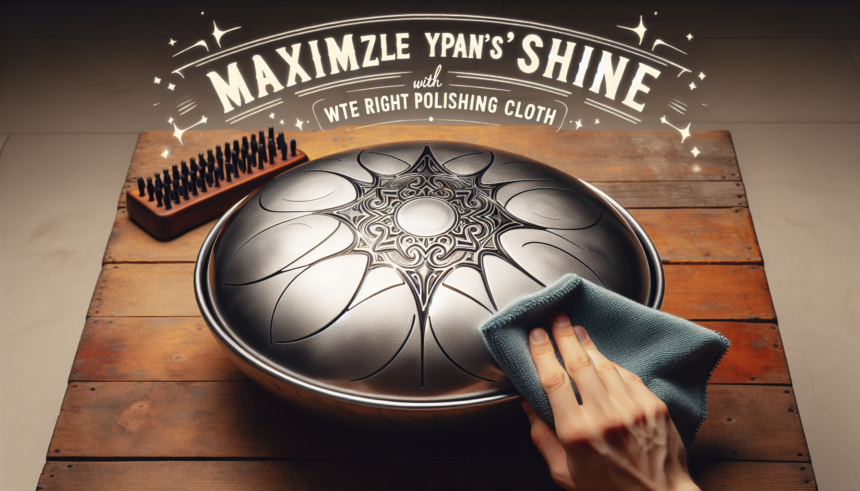The handpan is a unique and mesmerizing musical instrument that produces enchanting sounds and offers an immersive playing experience. Its ethereal tones have captured the hearts of musicians and enthusiasts around the globe. However, to ensure that your handpan continues to deliver exceptional performance and maintain its stunning appearance, regular upkeep is essential. One of the most critical aspects of handpan care is polishing. Selecting the correct polishing cloth could make the difference between a dull finish and a radiant shine that highlights the instrument’s intricate design and craftsmanship.
The Importance of Regular Polishing
Polishing your handpan is not merely a cosmetic activity; it has functional benefits as well. Handpans are typically made from steel, which can be prone to rust and oxidation over time. Regular polishing helps in removing harmful particles, oils, and fingerprints that could potentially degrade the instrument’s surface. A well-polished handpan not only looks beautiful but also ensures longevity and optimal performance.
Choosing the Right Polishing Cloth
When it comes to selecting a polishing cloth, the material plays a vital role in achieving the desired shine while ensuring that the surface remains free of scratches. Here are some commonly used materials and their benefits:
Microfiber Cloth
Microfiber cloths are incredibly popular for handpan polishing due to their softness and ability to trap dust and dirt effectively. They are made from very fine synthetic fibers, which ensure that the surface remains scratch-free. Additionally, they are highly absorbent, making them ideal for cleaning and polishing tasks.
Cotton Cloth
High-quality cotton cloths are another excellent option for polishing handpans. These cloths offer a gentle touch and effectively remove smudges and fingerprints. They are durable and easily washable, ensuring that they can be used multiple times.
Terry Cloth
Terry cloth, made from woven cotton, provides a slightly more abrasive option that is still gentle enough for handpans. It is particularly useful for removing heavier buildup and providing a deeper clean without causing damage to the instrument’s surface.
Polishing Techniques
Understanding the proper technique for polishing is as crucial as selecting the right cloth. Here are the steps you need to follow to maximize your handpan’s shine:
Preparation
Start by ensuring that your handpan is free of large dirt particles that could scratch the surface. Use a soft brush or a compressed air canister to remove dust and debris. This initial step is essential as it prevents any potential scratching during the polishing process.
Application
Apply a small amount of a suitable polishing agent or handpan oil to the surface. Make sure to choose products specifically designed for handpans to avoid any adverse effects on the metal. Spread the polish evenly using your selected cloth, working in small circular motions.
Polishing
Using your chosen polishing cloth, gently buff the surface of the handpan. Focus on each section individually, applying light to moderate pressure depending on the condition of the surface. Continue working in circular motions to ensure an even and thorough polish.
Final Touch
Once you have polished the entire surface, take a clean and dry microfiber or cotton cloth to remove any excess polish. This final step ensures a streak-free, gleaming finish. Repeat the polishing process as necessary to achieve the desired level of shine.
Maintaining Your Polishing Cloth
Proper maintenance of your polishing cloth is crucial to ensuring that it remains effective and free of contaminants that could scratch your handpan. Follow these tips to keep your cloth in top condition:
Regular Washing
After each use, wash your polishing cloth to remove any trapped dirt and polish residues. Use a mild detergent and avoid fabric softeners, as they can leave residues that may affect the efficiency of the cloth.
Air Drying
Air drying is the best method for drying your polishing cloth. Avoid using a dryer, as the high heat can damage the delicate fibers. Hang the cloth in a clean, dust-free environment to prevent any potential contamination.
Storage
Store your polishing cloth in a clean, dry place. Keep it separate from other cleaning tools and materials to avoid any cross-contamination. Using a dedicated container or bag can help maintain the cloth’s cleanliness and readiness for use.
Conclusion
Maximizing your handpan’s shine and ensuring its longevity requires the right tools and techniques. By choosing the appropriate polishing cloth and maintaining it properly, you can keep your handpan looking and sounding its best. Regular polishing not only enhances the instrument’s visual appeal but also protects it from potential damage caused by dirt, oils, and oxidation. Remember, a well-maintained handpan is a joy to play and a sight to behold.
FAQs
Q1: How often should I polish my handpan?
A1: The frequency of polishing depends on how often you play and the environment in which the handpan is stored. As a general rule, polishing once a month is sufficient for regular maintenance. However, if you notice the surface looking dull or showing fingerprints, you can polish it more frequently.
Q2: Can I use any polishing agent on my handpan?
A2: It is essential to use polishing agents specifically designed for handpans. Using the wrong products can cause damage to the metal surface. Look for products recommended by handpan makers or those specifically formulated for use on steel and similar materials.
Q3: What should I do if I see rust on my handpan?
A3: If you notice rust spots on your handpan, act promptly. Gently remove the rust using a specialized rust remover recommended for handpans, and then polish the affected area to restore its shine. Regular polishing and proper storage can help prevent rust from forming in the first place.
Q4: Can I use a polishing machine on my handpan?
A4: It is generally advisable to avoid using polishing machines on handpans, as they can be too abrasive and may cause damage. Manual polishing with a suitable cloth and gentle pressure is the safest and most effective method for maintaining your handpan’s finish.
Q5: How do I remove fingerprints from my handpan?
A5: Fingerprints can be easily removed by wiping the handpan with a clean microfiber cloth. For more stubborn marks, apply a small amount of handpan oil or polish and buff the area gently using circular motions. Make sure to clean and dry the surface thoroughly after polishing.





